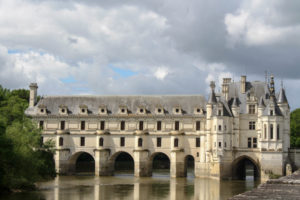
Chateau de Chenonceau
Quite the distinction to say Chateau de Chenonceau is the most visited and the most photographed chateau in the Loire Valley in France. It’s also been called the ladies chateau, as ladies have been the most influential in its design…from early on to the stunning structure we see today. Wives, mistresses, widows…all had their hand in the way Chateau de Chenonceau looks.
In the 16th century, Thomas Bohier and his wife Katherine Briconnet demolished an old castle and mill, which were standing on the site. Supposedly wanting to control the River Cher, the chateau sits all the way across it. Soon after completion, the chateau was seized by King Francois I, because Bohier couldn’t pay his debts. His successor, Henry II, gave the chateau to his mistress, Diane de Poitiers, who spent time and money redesigning the expansive gardens.
When Henry II died, his wife Catherine de Medici removed Diane and redid the gardens to her liking. More ladies and more renovations. When walking through the chateau, around every turn, in every room, on every staircase…there is a trace of one of the queens and mistresses who lived here.
Renaissance furniture, massive tapestries, paintings, and a small chapel are in fantastic condition. You can almost see how kings, their queens, and their mistresses lived here. The kitchen is its own special place. Or, should I say kitchens? There is one for baking breads, one for cutting meat, one for pastry work, one for bringing in the vegetables….and more. The copperware collection alone is worth looking at, and be sure to check out the 16th Century chimney in the pantry.
Chenonceau played an important part in more modern history as well. During WWI, the owner allowed the chateau to be used as a hospital, and during WWII one end of the castle was in the Occupied Zone and the other end in French Free Territory.
Definitely one of the prettiest chateau in the Loire Valley…in my opinion. Worth the visit.
For a special treat, have lunch at L’Orangerie, located on the grounds. Take your time…it’s worth it.